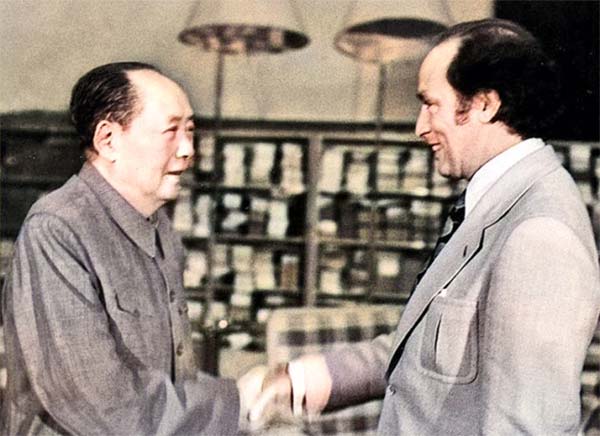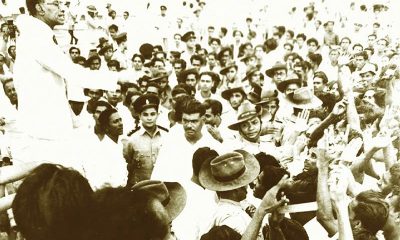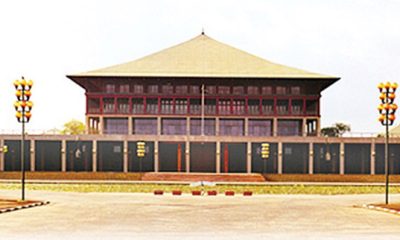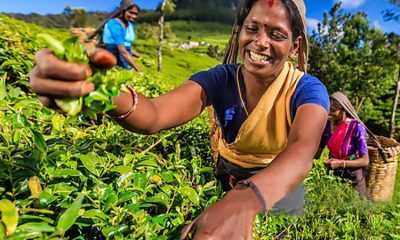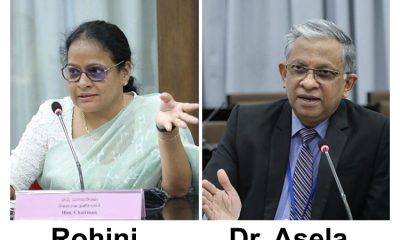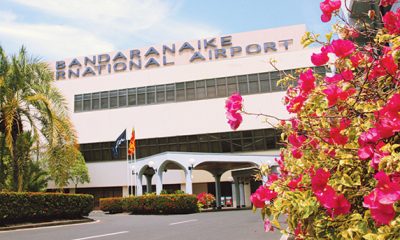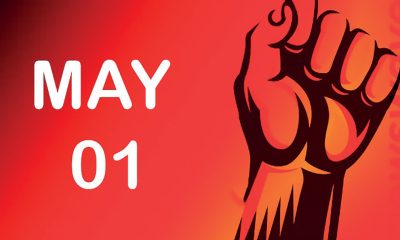Features
Biden and Trump vie for American Workers, Canada and India spar over Sikhs
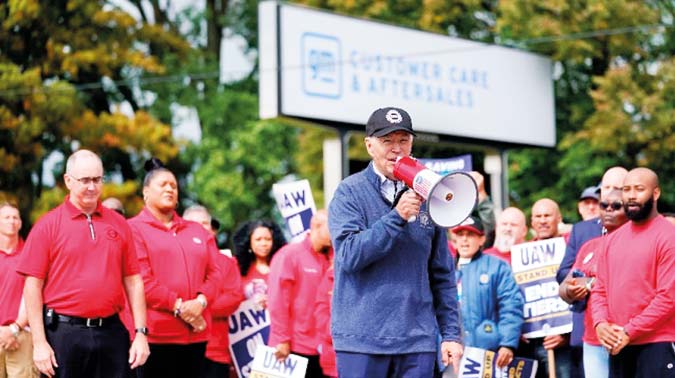
by Rajan Philips
After burdening this column by writing serially on political reforms, I was looking for a break from, yes, the Constitution. The Canada-India spat over Sikhs seemed a good topic for a thousand words, especially after the long distance lecture by Sri Lanka’s Foreign Minister to the government of Canada. The most that the lecture managed to accomplish was to make a splash across the Palk Strait in Chennai. Then came the breaking news of US President Joe Biden joining the striking auto-workers on their picket line in Detroit, Michigan. That is quite historic, not only for an American President but also for a head of state anywhere, including China.
It is also a very therapeutic topic to write about, inasmuch as in the world of politics it is usually one step forward and at least two of them backward. You grasp and make the most of whatever foot that progressively steps forward. On the other hand, it may not be therapeutic to write about President Ranil Wickremesinghe’s politics, but it is a Sunday hazard that some of us have grown addicted to. Mr. Wickremesinghe has of late been morphing into a flying president. Let us spare him this week while taking a break from the constitution.
Strike Solidarity
On Tuesday, September 26, President Joe Biden did something that no US President before him has done or would have thought of doing. He may have also set a precedent that future presidents will likely be forced to follow. Biden flew from Washington to Detroit and joined the striking United Auto Workers (UAW) union members who were on a picket line outside a General Motors’ Redistribution Centre in Wayne County, Michigan. Donning a UAW blue hat, the President mounted a wooden platform and used a bull horn to tell the workers, “You deserve what you’ve earned, and you’ve earned a hell of a lot more than you’re getting paid now. Then his middle class theme: “The unions built the middle class. That’s a fact. Let’s keep going.”
Not quite the socialist message, but a message you will hardly hear from another Head of State anywhere in the world today. Alexandria Ocasio-Cortez (AOC), the Democratic Congresswoman from New York and the pretty face of millennial socialism, would be pleased. She once remarked, as we were reminded recently in this paper, that she and Joe Biden will not be in the same party in any other country. In many other countries she could be in jail.
But that is America and where Ms. Cotez is assured of a virtual lifetime Congressional seat in a progressive borough, in the heart of New York City. It will not be easy to move up the American political ladder – as Senator, State Governor, or even US President, based solely on progressive politics and hard work. The US political system is stacked against people like AOC by the weight given to America’s insular hinterland in the Senate and in the Electoral College.
Reactionary and systemic stacking against progressives, let alone socialists, is not unique to America. That has been present from the beginning of representative democracy in any country and every country. And attempts at violently overthrowing representative democracy have produced cures that are worse than the ailments.
Yet Ms. Cotez, and her gallant Squad in Congress (that began with four women of colour in 2018 and has now grown to eight including two men) can make a world of difference for many Americans from where they are today. One of AOC’s main initiatives has been promoting the Green New Deal plan for fighting climate change along with fighting economic and racial injustice.
Although President Biden did not endorse the Green New Deal, he had no qualms in borrowing ideas from it for his own Plan for a Clean Energy Revolution and Environmental Justice. His signature legislative achievement is the euphemistically named Inflation Reduction Act (IRA), which includes specific measures for combating climate change. One of the key measures is at the core of the current labour dispute in the auto industry, and that is the shift from gasoline-driven cars to electric vehicles (EVs).
The Biden Plan goal is to make half of all new vehicles sold in America to be zero-emissions vehicles by 2030. That means greater production of EVs by auto makers, along with government commitment to providing federal funding and tax incentives, and installing 500,000 chargers to make EVs accessible nationwide. More so in rural America, the bastion of the political right, where 20% of Americans live and account for 70% of road miles of national travel. Just like the political lopsidedness. Now to the strike dynamic.
America’s big three in automakers (GM, Ford and Stellantis, which owns Chrysler) are laggers in EV manufacturing. They lag behind Tesla, BYD Auto and the Volkswagen Group, the three global leaders, by quite a distance. As they plan to repurpose their production base to increase EV production, the big three face competition from foreign automakers who are also eligible for the IRA tax incentives so long as their factories are in the US, Canada or Mexico. Some of them, mostly Japanese firms, already have their bases in one or more of the three free-trade countries. Also, unlike the big three, the foreign firms and the EV manufacturers like Tesla do not have unionized workers.
The top three are insistent that they cannot afford to pay the current union demands for wage increases and benefits, given the level of investments required for transitioning to EV; nor can they be competitive with automakers without unionized workforce. On the other hand, the union claims are based on the sacrifices workers made during the 2007-2008 financial crisis in order to keep the automakers solvent and in business.
The workers now want restoration of overtime work and retirement benefits, ending of wage differences between contract and permanent workers, as well as protection against potential labour retrenchment as part of EV production. The huge profits that the auto companies made during the Covid pandemic and the inflated salaries and bonuses that flowed to company CEOs, are not lost on the unions and the workers. Nor are they unaware of the huge financial support and tax benefits the US government is giving the automakers to switch from gasoline to electric vehicles.
In the backdrop to the labour dispute, there are both political interests as well as technological implications. On the latter, industry observers are opining that the transition from gasoline to electric vehicles involves “the biggest technological transformation since Henry Ford’s moving assembly line started up at the beginning of the 20th century.” And the workers and their unions are determined not to get shortchanged a second time as they were at the last technological changeover, not to mention the start of the industrial revolution itself. However, there is a major difference between the age of Ford and the present time, and it is that the economy now is highly diversified and is not ‘over-determined’ by a single industry.
And then there is politics, with the presidential election coming up next year. Regardless of the Republican primary clown show and Democratic party doubters, President Biden and Donald Trump would seem to have decided that they are the de facto candidates and that it is time to start the real campaign. After President Biden’s visit to the picket line of striking union workers, Donald Trump visited Drake Enterprises, a non-union auto parts supplier in Clint Township, Michigan. Trump’s pitch is of course diametrically the opposite. He wants union workers to peel away from their leaders and vote for him because he will save their jobs by removing the requirement for shifting from gasoline to electric vehicles.
The trouble with that reactionary approach is that Mr. Trump will not find any takers for it from any of the main automakers. But Trump being Trump, he is not interested in the fallout for the auto industry or the American economy, let alone climate change. He is only interested in using any slogan to win back the workers who voted for him in 2016 in the three battleground states of Michigan, Wisconsin and Pennsylvania. Trump won all three of them in 2016 and lost them all to Biden in 2020. And Joe Biden will do everything to keep those states on his side of the tally. Including, joining a picket line.
Canada stuck between China and India
From the auto industry and presidential politics in the US, it is quite a stretch to comment on the recent spat between Canada and India over Sikhs and their politics in the two countries. But in the ‘globalized world’, everything is interconnected, hierarchically and horizontally. It is the global interconnections that Antonio Negri and Michael Hardt may seem to have captured in conceptualizing the current global order by counterposing the new global Empire (of superpowers – past, present and wannabe) and its anthesis, the new global Multitude.
One of the empirical processes driving the global multitude is the movement of people across nation-state boundaries. In this process, China and India are giant exporters of the multitude and Canada is literally caught up between them as one of the main recipients of global migrants. And the government of Prime Minister Justin Trudeau that has more immigrant ministers than any other government in the world has become the object of derision and vilification both by India and China, as well as its domestic detractors.
For the greater part of this year the Trudeau government has been facing relentless criticism from opposition parties and the media for its alleged failure to deal with Chinese interference in Canadian elections and intimidations of Chinese Canadians who are opposed to the Chinese government and its representatives in Hong Kong. The criticisms became personal and right wing attacks targeted the Trudeau family as having a soft spot for China, even harking back to then Prime Minister Pierre Trudeau’s historic 1973 visit to China as a breakout leader from the western world.
The critics conveniently forgot that for nearly three years (December 1, 2018, to September 4, 2021) the Trudeau government was delicately pre-occupied with getting the release of Michael Spavor and Michael Kovrig (the two Michaels), two Canadian citizens who were arbitrarily jailed in China, in retaliation to the detention of Meng Wanzhou, the daughter of the founder of the Chinese tech giant Huawei and its Chief Financial Officer.
Her detention, while travelling through Canada, was in response to a US extradition request for allegedly violating US sanctions against Iran. All three were finally released following a tripartite understanding between the US, China and Canada.
There was a chorus of calls for an independent public inquiry into Chinese interference. After months of back and forth, the government and the opposition have agreed on the launching of a Public Inquiry into “Foreign Interference in Federal Electoral Processes and Democratic Institutions.” The inquiry will be led by an Appeal Court Judge from the Province of Quebec, and will cover not only China but also Russia and other countries with alleged interferences.
Just when the hullabaloo over Chinese interference seemed to be quietening down, Prime Minister Trudeau dropped a bombshell in a statement to parliament on September 19, that there were “credible allegations of a potential link” between Indian government agents and the killing of 45 year old Hardeep Singh Nijjar in June, near Vancouver. Mr. Nijjar was born in India and fled to Canada in 1995 as a teenage refugee allegedly to escape a government crackdown on Sikh activists in Punjab.
He worked as a plumber and was a community leader. In 2019 he became the leader of the Guru Nanak Sikh Temple in Surrey, Vancouver. He advocated Sikh separatism through non-violent means and was one of the organizers of the Khalistan Referendum campaign. He was killed by masked gunmen outside the Guru Nanak Temple.
The Indian government rejected Trudeau’s allegation as absurd and accused the Canadian government of not heeding India’s concerns over Sikh separatist activities in Canada. There have also been questions about Mr. Trudeau’s decision to make an open statement when he was not in a position share detailed information in public.
Apparently, he was forced to go public with his allegation to pre-empt media outlets that were set to publish the story based on their own investigations. It is also known that Mr. Trudeau raised this matter with Prime Minister Modi during the G 20 Summit in New Delhi and asked for the Indian Government’s co-operation in investigating the killing.
Prior to that, Canadian intelligence and security officials have visited India multiple times for discussions with their Indian counterparts. The intelligence premise for Canada’s allegations came through the interception of communications between New Delhi and the Indian High Commission in Ottawa, reportedly by the old Five Eyes (comprising Australia, Canada, New Zealand, the UK and the US) intelligence network. Canada’s concerns were and are shared by its traditional allies. It is also reported that in the face-to-face meetings between Canadian and Indian officials, Canada’s allegations were not formally denied, in contrast to the vigorous rejections in India’s public statements.
After his explosive statement in Parliament, Prime Minister Trudeau has appeared to be trying to calm diplomatic waters by insisting that Canada is “not looking to provoke or escalate.” He has gone on to say, “We are simply laying out the facts as we understand them and we want to work with the government of India to lay everything clear and to ensure there are proper processes.” Further, “India and the government of India needs to take this matter with the utmost seriousness.” Similar diplomatic overtures are said to have emanated from the Indian side. After the initial furor, there seems to realization on both sides to let quiet diplomacy take its course.
Features
How the ‘Lost Tribes of Israel’ help in understanding Mid-East peace issues

 Reports that the Israeli authorities have given the ‘go ahead’ for the repatriation and integration into the Israeli populace of some survivors in parts of India from what are described as the ‘Lost Tribes of Israel’, bring up a subject that merits continuous and focused research. The contemporary observer of international politics seeking to understand more thoroughly the factors fueling the Middle East conflict and the crucial role identity issues play in it would, no doubt, be the biggest beneficiary of such research.
Reports that the Israeli authorities have given the ‘go ahead’ for the repatriation and integration into the Israeli populace of some survivors in parts of India from what are described as the ‘Lost Tribes of Israel’, bring up a subject that merits continuous and focused research. The contemporary observer of international politics seeking to understand more thoroughly the factors fueling the Middle East conflict and the crucial role identity issues play in it would, no doubt, be the biggest beneficiary of such research.
In the global South in general there has hitherto been a tendency to soft peddle what may be called ‘the Israeli side of the story’. While the situation of the Palestinians has generated wide-spread empathy for them and very rightly so, an understanding of the causes prompting the Israelis to think and act as they do has gone comparatively unaddressed. This is a glaring lacuna in Southern scholarship in particular on the Middle East question. But if the international community is to pave the way for even a measure of reconciliation in the region the points of view of both sides to the conflict need to be more thoroughly understood.
A news report on page 3 of this newspaper on December 12, 2025 titled, ‘ Israel is moving Lost Tribe Jews from India’, is compulsory reading for those seeking to understand the history of Israel in its essentials. Going by Biblical History in particular the stark truth is that the Israelis were as persecuted as the Palestinians. It could be said that this process began in ancient times even before the birth of Jesus Christ a little over 2000 years ago.
The Old Testament of the Bible is essential reading for an understanding of the history of the Israelis, who are also referred to as ‘The Chosen People of God’. It is a history replete with persecution, mind-numbing war and suffering. The Israelis were continually harassed, subjected to extreme suffering and were displaced from the land they were settled in; which roughly corresponds to today’s Palestinian territories.
The Books of the Old Testament tell us that right through ancient times the Jews, today’s Israelis, suffered displacement, particularly at the hands of the then regional powers, Egypt, Persia and Assyria, and were taken captive to the lands of the conquerors or were reduced to slavery in their own territories. Consequently, displaced Jews escaped to the most distant parts of the world. This is how they happened to be in India as well. However, the fact to note is that the Jews were at one time a settled community with territories of their own.
What is exemplary about the Israeli or Zionist state that was established in 1948, under the overlordship of the old imperial powers, such as Britain, is that it invited the Jews spread virtually all over the world to return to their homeland, the Zionist state. Accordingly, as the report of December 12 reveals, the remnants of the Jewish tribes in India, for example, numbering some 5,800 persons, are being taken back to Israel from India’s Mizoram and Manipur states. Also of note is the fact that the Jews were originally members of 12 tribes, which figure thought-provokingly corresponds to Jesus’ 12 apostles.
According to the news report, these repatriation moves by the Israeli state are not bereft of some strategic motives, such as the strengthening of the Israeli presence in areas bordering Lebanon, for example, which are seen as vulnerable to Hizbollah attacks. The repatriation moves are also interpreted as part of efforts to ‘Judaize’ the Galilean region in particular with a view to reducing the Arab-Islamic presence there, since these areas are also home to a considerable number of Arabs. Since the possibility of friction between the Israeli settlers from India and the Arabs cannot be ruled out, we could very well be seeing the prelude to stepped-up ethnic cleansing exercises by the Israeli state in these security-sensitive border areas.
The larger problem for the international community, given this backdrop, is ‘ where we could go from here’ with regard to making forward moves towards realizing even a measure of peace and reconciliation in the Middle East. The Israeli state is doing well to open its doors to the returning Jewish diaspora readily but given the current power configurations in Israel, transitioning to Middle East peace could remain a distant prospect.
To ascertain why peace remains elusive in the region one would need to factor in that the Netanyahu regime in Israel is of a Far Right orientation. Such regimes usually keep countries internally divided and virtually at war with themselves by exploiting to their advantage, among other things, identity issues. The settlement of persons hailing from ‘Lost Israeli Tribes’ in security-sensitive regions offers the Netanyahu regime the latest opportunity to pit one community against the other in these regions and thereby consolidate its influence and power over the Jewish majority in Israel.
Ethnic-cleansing exercises orchestrated by the Israeli centre take this process to a ‘new high’ and are based on the same destructive reasoning. Basically, the underlying logic is that the Jewish nation is under constant attack by its rivals and should be on a constant war footing with the latter.
Unfortunately the US is at present not doing anything constructive or concrete to further the cause of a fair Middle East peace. Its peace effort in the region has, to all intents and purpose, run aground; presuming that the US was, indeed, intent on pursuing a Middle East settlement. Nor is the US bringing pressure to bear on Israel to make some headway towards some sort of solution. In the absence of these essential factors the Middle East is bound to remain in a state of war.
While it ought to be granted that the Jews have a long history of persecution and victimization, the Israeli state is not doing its citizens any good by keeping these harrowing memories alive for the purpose of power-aggrandizement and by following a policy of pitting one community against the other. While the Jewish legacy of victimhood needs to be abandoned, the Jewish people would be doing themselves immense good by guarding against voting into office Right wing governments that thrive on the ruthless exploitation of identity issues.
Features
Presidential authority in times of emergency:A contemporary appraisal
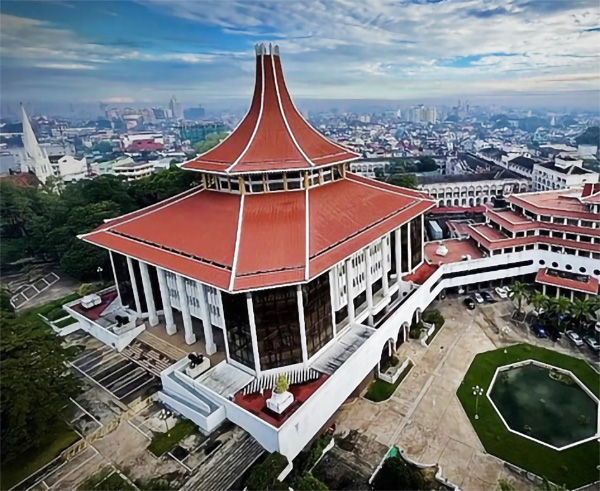
Keynote Address Delivered at the International Research Conference of the Faculty of Law, University of Colombo, on 12 December 2025.
1. The Policy Dilemma
One of the great challenges of modern public law is to reconcile traditional principles relating to the rule of law and the separation of powers with the exigencies of crises which threaten the destruction of society itself. To what extent must protective mechanisms developed by systems of law over the ages give way to the need for physical survival in the throes of life-threatening crises? What is the right balance to be struck, as a matter of public policy?
The classic statement is by John Locke, who insisted that, in emergencies, the government should have legally unfettered power “to act according to discretion, for the public good, without the prescription of the law, and sometimes even against it” (Second Treatise of Government). This is an ancient idea which goes back to Roman times, when Cicero, in his famous oration, Pro Milone, declared: “Inter arma silent leges” (“Amid the clash of arms, the laws are silent”).
This received expression in the present century in the work of Carl Schmitt, who insisted that “The sovereign is he who decides on the state of exception” (Political Theology:Four Chapters on the Concept of Sovereignty). According to him, not only is the sovereign’s authority untrammelled during emergency, but the declaration of emergency is his right alone, dependent solely on the exercise of his subjective judgment. This unqualified power springs from the supreme law of nature—-the safety of the people.
Judicial pronouncements across the world explicitly reflect this point of view. Justice Story, on behalf of the Supreme Court of the United States, famously declared: “The question arises, by whom is the exigency to be judged and decided? We are all of opinion that the authority to decide whether the exigency has arisen, belongs exclusively to the President, and that his decision is conclusive upon all other persons” (Martin v. Mott).In Ghulam Sarwar v. Union of India, Subba Rao CJ, speaking for the Supreme Court of India, observed: “The question whether there is grave emergency is left to the satisfaction of the Executive, for it is obviously in the best position to judge the situation”.
There is, however, equally emphatic opinion to the contrary. Khanna J, in a celebrated dissent, was scathing in his denunciation of the opposite approach: “The position would be that, so far as executive officers are concerned, in matters relating to life and personal liberty of citizens, they would not be governed by any law, they would not be answerable to any court, and they would be wielding more or less despotic powers” (Additional District Magistrate, Jabalpur v. Shivakant Shukla).
These competing postulates have been articulated with equal passion.
II. A Landmark Pronouncement by the Supreme Court of Sri Lanka
The Supreme Court of Sri Lanka had recently to deal with this issue frontally (Ambika Satkunanathan v. Attorney General). This is a watershed decision because, for the first time in our legal history, the Supreme Court held that an Acting President of the Republic had violated the fundamental rights of the People, enshrined in the Constitution, by the declaration of a State of Emergency.
The circumstances against the backdrop of which this historic ruling was made, are well known. A serious depletion of foreign reserves resulted in a severe shortage of basic amenities like fuel, cooking gas, electricity, staple food items, and medicine. In the context of an unprecedented default in the repayment of foreign loans and significant depreciation of the rupee, extended power cuts and galloping inflation led to acute economic hardship. These circumstances culminated in unrest on a scale never seen before on the Island.
Violence included the brutal murder of a Member of Parliament, the torching of residences of the Prime Minister and more than 70 other political personalities, forcible occupation of the Presidential Secretariat, the President’s official residence and the Office of the Prime Minister, with almost a million people gathered in Colombo demanding the resignation of the President. The elected President had fled the country, and a date had been set for an urgent meeting of Parliament to elect the President in accordance with procedure spelt out in the Constitution. An unruly mob had encircled Parliament, threatening to prevent this meeting from taking place. This was the situation in which Acting President Ranil Wickemesinghe declared a State of Emergency.
He did so in terms of provision in the Public Security Ordinance, which empowered him to take this action, if he was of opinion that this was “expedient in the interests of public security and the preservation of public order, or for the maintenance of supplies and services essential to the life of the community”(section 2).
The decision was that of a divided Supreme Court. The majority consisted of Murdu Fernando CJ and Yasantha Kodagoda J, while there was a vigorous dissent by Arjuna Obeyesekere J. The minority held that the circumstances warranted the opinion entertained by the Acting President, while the plurality declared themselves prepared to make this assumption. This, then, was common ground. The difference of opinion pertained to another vital issue.
Once the Acting President (hereinafter referred to as the President), had reached this conclusion, he had four optional courses of action available to him:
(i) He could have recourse to the routine law, principally the provisions of the Penal Code and the Criminal Procedure Code, to deal with the situation;
(ii) He could invoke Part III of the Public Security Ordinance, which would enable him to take particular actions such as calling out the Armed Forces to supplement the Police, prevent public gatherings on highways and in the vicinity of bridges and other specified locations, and declare curfew. These measures could be taken, short of proclamation of a State of Emergency;
(iii) He could take the “drastic step”, under Part II of the Public Security Ordinance, to bring into force the provisions contained within that section, in terms of which an Emergency could be declared, applicable to the whole Island;
(iv) While declaring an Emergency under Part II, he could confine its operation to particular parts of the Island.
This is where the difference of opinion between the plurality and the minority of the court manifested itself. The majority was of opinion that the President’s satisfaction relating to the existence of objective conditions justifying declaration of Emergency did not automatically entitle him to go the full length of bringing into being a nationwide Emergency under Part II, but obligated him further to consider whether measures of a more limited nature, contemplated by Part III, would be sufficient to deal effectively with the situation.Failure to do so, according to their ruling, would involve a breach of the Constitution.
By contrast, the minority was convinced that “Once the President has come to the conclusion that a state of public emergency exists, there is no purpose in mandating a consideration of other options”, and that “Requiring the President to embark on whether the ordinary laws or other various provisions or options would be adequate to deal with a public or national emergency, would be unreasonable and an unprecedented step”. On this basis, the minority held that the President’s actions were entirely within the Constitution, and entailed no liability for contravention of fundamental rights.
A great deal hinged, in practical terms,
on the divergence between these points of view.
III. Categories of Emergency: Uniform or Disparate Rules?
Contemporary trends in the law acknowledge marked differences in scale, intensity, and duration among types of emergency which precipitate varying degrees of government paralysis.
South African law incorporates one comprehensive definition of a State of Emergency, capable of invocation when “the life of the nation is threatened by war, invasion, general insurrection, disorder, natural disaster, or other public emergency” (Constitution, Article 37(1)(a)). Preferable, by far, is the position under the Emergencies Act of Canada, which recognises four different kinds of emergencies— natural disasters, threats to public order, international emergencies, and states of war (Section 18(2)). This enables different degrees of Parliamentary scrutiny and control.
The Constitution of India provides another example of this approach. Article 352 envisages a threat to the security of India or any part of the country by reason of war, external aggression or armed rebellion, while Article 356 contemplates a failure of constitutional government in any Indian state, and the context of Article 360 is jeopardy to the financial stability or credit of India.
In the spectrum of gravity, peril to the very existence of the state, in the degree present in the Sri Lankan situation, attracts the highest concern. In circumstances of potential government breakdown, “facile distrust” is not the recommended counsel. The courts of India have cautioned that “When there is a crisis situation, it is necessary to trust the government with extraordinary powers in order to enable it to overcome such crisis” (Bhagvati J. in Shivakant Shukla).
Undue concern about a lawless situation, typified by unbridled executive power, is not realistic. Emergency legislation has rightly been characterized as “extra-legislative legislation”. Far from there being a legal vacuum, systems of law have furnished practical safeguards, while enabling public order to be maintained.
One of these is the imaginative “super-majority escalator” technique, characteristic of South African law. Only a simple majority of Parliament is required to approve a State of Emergency operative for a maximum period of 21 days, and to extend it up to 3 months. Beyond that, a 60% majority is compulsory for further extensions (Article 37). Here, then, is a successful reconciliation of competing objectives.
Article 16 of the Constitution of the Fifth Republic in France empowers the President to determine not only the sufficiency of conditions warranting the declaration of a State of Emergency, but also its appropriate duration. Restraints on Presidential power in France are weak because the President, although required to consult the Conseil Constitutionel (Constitutional Court), is not bound by its advisory opinion, in the event of contrary advice.
Relative amplitude of Presidential power in emergency situations in France has been justified by a prominent French jurist, François Saint-Bonnet, on the basis that the curtailment of emergency powers at the disposal of the Executive carries the risk of deprivation of the very tools which the government finds indispensable to combat the threat.
Germany’s Basic Law, although wary of emergency powers because of the harrowing experience of Article 48(2) of the Constitution of the Weimar Republic, which paved the way for the rise of Hitler, nevertheless does not balk at recognizing “internal emergencies” which enable intervention by the Executive, albeit subject to control by the Federal Parliament.
Constitutional provisions in different jurisdictions, irrespective of the approach selected, envisage substantial executive power in times of emergency, curtailed by surveillance on the part of the elected Legislature.
IV. Restraints on Judicial Intervention
The decided cases in many countries are replete with examples of indicia which concede to the Executive great latitude in these contexts. The recurring feature is the urging of restraint in the exercise of judicial review in keeping with a suitably benign construction, consistent with constitutional standards. This is reflected in unimpeachable academic authority, as well.
It has been insisted that executive decisions “should be taken seriously as a bona fide attempt to solve whatever social problem they set out to tackle”(Aileen Kavanagh).The caution has been administered that judges should exercise great caution before concluding that the government has violated constitutional rights(Prof. T. R. S. Allan) and,in public emergencies threatening the life of the nation, elected officials should be permitted “to err, if at all, on the side of safety”(Lord Bingham).The courts “should resist the temptation to substitute their own preferred solutions to questions of public policy”(Allan).
This is so, for a number of reasons. One of them is that the public authority is entitled to latitude because it has “a kind of responsibility to advance the public interest that a court does not have”(Brooke L.J.).This is reinforced by other considerations. For instance, possession of special expertise by the executive authority is an important factor.
The nature of the subject matter, for this very reason, has a vital bearing on the issue. Judges have been conscious that “the more political the question is, the more appropriate it will be for political resolution, and the less likely it is to be an appropriate matter for judicial decision”(Lord Bingham).
A responsible and representative system of democratic governance brings into sharp focus “the degree of democratic accountability of the original decision maker, and the extent to which other mechanisms of accountability may be available”(Murray Hunt).Basic values of constitutionalism identify Parliamentary controls as infinitely preferable, in this regard, to judicial intervention.
This has to do with the nature and legitimate confines of the judicial function. Mirza Beg J, speaking for the Supreme Court of India, has candidly conceded that “the judicial process suffers from inherent limitations”(Shivakant Shukla).This is essentially because a court “can neither have full and truthful information, nor the means to such information”(Chandrachud J in Shivakant Shukla),especially in respect of classified information.
An absolute imperative is that the distinction between judicial review and substitution of judgment must be scrupulously observed. Admittedly contextual, this principle is of overriding significance because it is “wrong to expect executive bodies to replicate the style of analysis adopted by courts in determining allegations of violation of rights”(T. R. S. Allan).
It is crucial for the rule of law that the dividing line between these two distinct functions should not become inadvertently blurred. It is not necessary for the public authority to address itself to the same legal arguments as the court(Court of Appeal of England in the Begum case),the judicial function being restricted by the consideration that “the court is usually concerned with whether the decision maker reached his decision in the right way, rather than whether he got what the court might think to be the right answer”(Lord Hoffmann).
The raison d’etre underpinning executive intervention in these extraordinary situations should be constantly borne in mind. The reality is the absence of a practical substitute. “Neither the legislature nor the judiciary is capable of swift, energetic action, which leaves the executive by default as the authoritative body”(David Dyzenhaus).For this inescapable reason, there has been constant emphasis that executive actors “should not be deterred from engaging in the very activity needed,and contemplated, to deal with the crisis”.
The overarching object of policy is the preservation of public confidence. “The faster and more effective the response, the smaller the overall damage to society, as a whole. The best way for government to respond to these fears is to do something large and dramatic to reassure the populace”(Bruce Ackerman).
The weight attaching to these elements of public policy is self-evident. (To be continued)
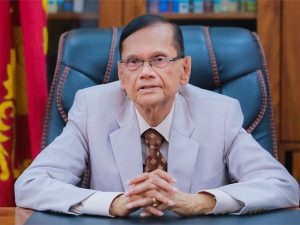 By Professor G. L. Peiris
By Professor G. L. Peiris
D. Phil. (Oxford), Ph. D. (Sri Lanka); Rhodes Scholar,Quondam Visiting Fellow of the Universities of Oxford, Cambridge and London; Former Vice-Chancellor and Emeritus Professor of Law of the University of Colombo.
Features
90th Anniversary of LSSP and leftism in Sri Lanka

The Lanka Sama Samaja Party was formed on the 18th of December 1935. Its four leaders were Dr. N. M, Perera, Dr. Coivin R, de Silva, Philip Gunewardena and Leslie Goonewardene, who also became the General Secretary. (Prior to this, in 1933, the Wellawatte Mills strike first led to their getting together in action). It must be mentioned that The LSSP was the first properly constituted political party in the country. It was also the first genuine Left party and its political philosophy was based on Marxism-Leninism. It took the name ” Sama Samaja”, which means ” Equal Society”, as, at that time, the people in Sri Lanka were unfamiliar with the terms Socialism and Communism. It was quickly accepted by the people and, despite the use of state power and thuggery against the LSSP by the local capitalist class, backed by the British rulers, the Party rapidly gained popularity among the people. In the General Election of March 1936 Dr. N. M. Perera was elected to represent the Ruwanwella electorate and Philip Gunawardena the Avissawella electorate. Unfortunately, Dr. S. A. Wickramasinghe was unable to retain Akuressa, which he had won in the 1931 Election, and Leslie Goonewardene failed to win Panadura due to the use of caste and money unfairly against him. Leslie, throughout his political career, refrained from descending to such a low level of politics But the LSSP stand helped in the process of uniting and politicisation of the people which was necessary to generate the confidence of the people in their ability to win Complete Independence through the democratic process.
Throughout its history a major role in the success of the LSSP was its provision of support to the struggles of the working class to win its rights. Dr. N. M. Perera formed the Ceylon Federation of Labour and, as its President, he organised the trade union movement to focus on winning their genuine demands as a class. He negotiated with the employers and won many demands across the table, and resorted to strike action as a last resort. He won the respect of both employees and employers as a leader who did not misuse the trade unions for personal vendettas. He used Parliament in a responsible manner to fight on behalf of the workers, while informing the public who suffered as a result of the strikes that the demands were just, and winning their support as well. The LSSP unions have maintained these values and continue to serve the working class
The LSSP was aware of the problem of poverty leading to hunger as a major factor that affected the life of a majority of our people. A survey done at the MRI, about two years ago, showed that 63% of families had an income below the poverty line. They could not have three adequate meals per day. Some had two meals and others only one that met their nutritional needs. The children and mothers were particularly vulnerable. The malnutrition level in that study was 14.3%. But the situation appears to be worse now. The Suriyamal Movement led NM to one of the worst affected areas, Kegalle. The focus was on malaria eradication, but they had to also address the problem of poverty and hunger. Rice, dhal and coconut sambol were provided. NM came to be known as “Parippu Mahaththaya” as a result. The LSSP is reviving the Suriyamal Movement which has become an urgent need after the Climate Change. Any help will be welcome.
We celebrate Independence Day alone, but India also celebrates Republic Day. It is the latter that gave India sovereignty, without which independence is empty. They won it within three years, with Ambedkar drafting the Republican Constitution. The LSSP kept on pressing for it but the comprador capitalist class, led by the UNP, kept delaying as they were happy with Dominion status. The LSSP joined the SLFP and CP to form the coalition government, led by Sirimavo Bandaranaike, in 1970, and Dr. Colvin R. de Silva was made the Minister of Constitutional Affairs. He finally drafted the Republican Constitution in 1972. Sri Lanka took 24 years to do this and we can hold our heads up as we are now politically a truly independent sovereign nation. But we remain a poor underdeveloped country with widespread unemployment and underemployment, especially among the youth. The number of those in poverty is rising while the rich are becoming super rich. The rich/poor gap is widening and it may explode. It is sad to see that Sri Lanka is far away from the Welfare State that the LSSP, led by Dr. Perera, strove to build. As Minister of Finance, he kept the cost of living down, balanced the Budget and did not tax the poor. He had a high direct tax on those who could afford to pay this. Unlike now, the priority was given to use the limited forex to buy essential medicines,not luxury vehicles.
As Minister of Science and Technology, I started the Vidatha Movement to provide the technology and finance for Small and Medium Enterprises (SMEs) countrywide, one centre headed by a science graduate in each division. I am told that more than 50,000 entrepreneurs have emerged marketing their products sustainably. More than one thousand are exporting their products. I appeal to the NPP government to continue to support them. We must develop into an industrial nation if we are to emerge from poverty. I and the LSSP will give all support. By the way, our armed forces can defend our country. We do not need American forces.
by Prof. TISSA VITARANA
(Leader and General Secretary, LSSP)
-

 Features5 days ago
Features5 days agoWhy Sri Lanka Still Has No Doppler Radar – and Who Should Be Held Accountable
-

 Features7 days ago
Features7 days agoDitwah: A Country Tested, A People United
-

 News16 hours ago
News16 hours agoPakistan hands over 200 tonnes of humanitarian aid to Lanka
-
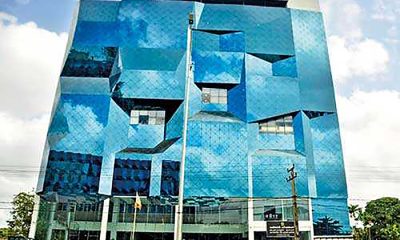
 News7 days ago
News7 days agoRs 1. 3 bn yahapalana building deal under investigation
-

 News16 hours ago
News16 hours agoPope fires broadside: ‘The Holy See won’t be a silent bystander to the grave disparities, injustices, and fundamental human rights violations’
-

 Business7 days ago
Business7 days agoFluctuating fortunes for bourse in the wake of selling pressure
-

 Opinion7 days ago
Opinion7 days agoComfort for some, death for others: The reality of climate change
-
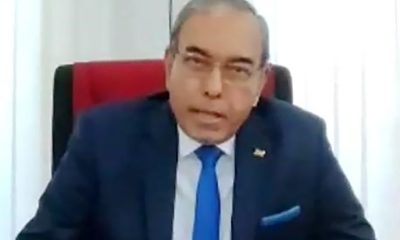
 News7 days ago
News7 days agoFormer SAARC SG Esala Weerakoon calls for ‘South Asian Climate Compact’

